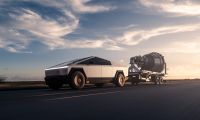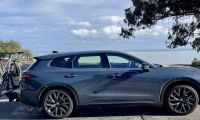This year Rivian, Bollinger, Hummer, Aptera, and Lucid might ship an electric vehicle of some type to a customer. Or they may not. We hope they do. So do many electric vehicle enthusiasts. Being a "bird in hand" type of electric vehicle enthusiast, I thought a quick story about Mitsubishi's electric vehicles in America might give some perspective.
Mitsubishi's First BEV In America
Mitsubishi was one of the first automakers to put an all-electric vehicle into the hands of actual owners nearly ten years ago. There were Mitsubishi electric vehicles being driven by the automotive press in America before Nissan's Leaf, Chevy's Volt EREV, before the BMW i3, and of course, before Tesla was even a twinkle in the eye of a clever guy working at PayPal.
The i-MiEV from Mitsubishi was the best EV one could buy in 2011. Because it was one of two you could buy in 2010. In terms of what we now expect from an EV, the i-MiEV was terrible, But back in 2010, Autoweek gave it a very upbeat and welcoming review. Autoweek's Mark Vaughn eventually spent five years with the i-MiEV and said, "... I love it. That’s right, I said it. Me, who today was driving a 450-hp Eleanor Mustang, who just two days ago was driving (I am not making this up) a 1968 Shelby Cobra GT500 KR with the 428 and a four on the floor. Me, the very same dope who only a short while before that was flying along in a McLaren 570GT. Me who… “Awright,” you’re thinkin’, “Quit yer yappin’ and get to the point already!”
The i-MiEV was a smaller-than-subcompact city car with no specs worthy of posting today. The point is, Mitsubishi was on the path to electrification before any of the brands with vaporware EV supercars breathlessly being reported on today by the EV press.

America's First Affordable Electrified Crossover - Mitsubishi Outlander PHEV
Nobody in America wants a small EV. Bolts are lingering forever on dealer lots despite discounts bringing prices down to below $20K in all-blue, pro-EV New England. What buyers need and want is an affordable electrified crossover. Mitsubishi was also the first automaker to fill that need. The Outlander Plug-in Hybrid-Electric Vehicle (PHEV) may not have been the ideal EV for every person, but it was an electrified version of the type of vehicle that is the top-selling in America, a crossover.
We've twice tested the Outlander PHEV for a week and also have compared it back to back with other EVs at media events. While there is certainly room for improvement in this vehicle, Mitsubishi, to its credit, knows this and has taken action. The 2021 Outlander PHEV saw small improvements in specs, but bigger changes under its skin. In 2022, Mitsubishi will launch its all-new Outlander crossover PHEV, and will become the second automaker in America to offer a second-generation affordable electrified crossover when that happens. Toyota is presently on its third generation of its electric RAV4.
Related Story: Mitsubishi Outlander PHEV Goes 160,000 Miles With Only Routine Maintenance
We are excited to report on the new Rivian R1T if it launches this June. We are looking forward to the Bollinger EV, Aptera EV, and the Lucid EVs coming. However, we felt it was worth noting that one of America's smallest automakers has been selling EVs in America as long as anyone but Nissan, and is well on its way to a new product that will allow mainstream consumers to buy an EV that fits their needs.
John Goreham is a long-time New England Motor Press Association member and recovering engineer. Following his engineering program, John also completed a marketing program at Northeastern University and worked with automotive component manufacturers. In addition to Torque News, John's work has appeared in print in dozens of American newspapers and he provides reviews to many vehicle shopping sites. You can follow John on Twitter, and view his credentials at Linkedin












